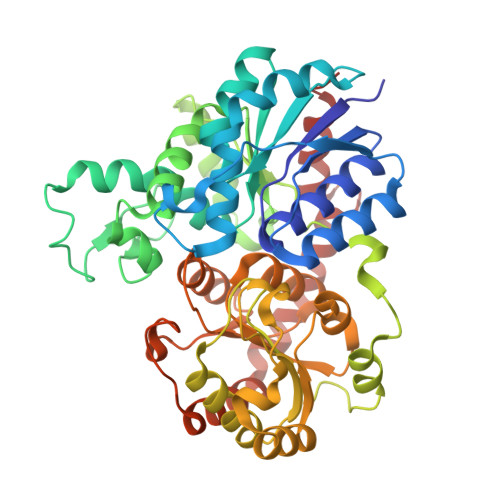An efficient C-glycoside production platform enabled by rationally tuning the chemoselectivity of glycosyltransferases.
Li, M., Zhou, Y., Wen, Z., Ni, Q., Zhou, Z., Liu, Y., Zhou, Q., Jia, Z., Guo, B., Ma, Y., Chen, B., Zhang, Z.M., Wang, J.B.(2024) Nat Commun 15: 8893-8893
- PubMed: 39406733
- DOI: https://doi.org/10.1038/s41467-024-53209-1
- Primary Citation of Related Structures:
8XFH, 8XFW - PubMed Abstract:
Despite the broad potential applications of C-glycosides, facile synthetic methods remain scarce. Transforming glycosyltransferases with promiscuous or natural O-specific chemoselectivity to C-glycosyltransferases is challenging. Here, we employ rational directed evolution of the glycosyltransferase MiCGT to generate MiCGT-QDP and MiCGT-ATD mutants which either enhance C-glycosylation or switch to O-glycosylation, respectively. Structural analysis and computational simulations reveal that substrate binding mode govern C-/O-glycosylation selectivity. Notably, directed evolution and mechanism analysis pinpoint the crucial residues dictating the binding mode, enabling the rational design of four enzymes with superior non-inherent chemoselectivity, despite limited sequence homology. Moreover, our best mutants undergo testing with 34 substrates, demonstrating superb chemoselectivities, regioselectivities, and activities. Remarkably, three C-glycosides and an O-glycoside are produced on a gram scale, demonstrating practical utility. This work establishes a highly selective platform for diverse glycosides, and offers a practical strategy for creating various types of glycosylation platforms to access pharmaceutically and medicinally interesting products.
- Key Laboratory of Chemical Biology and Traditional Chinese Medicine Research (Ministry of Education) and Key Laboratory of Phytochemical R&D of Hunan Province, College of Chemistry and Chemical Engineering, Hunan Normal University, 410081, Changsha, P. R. China.
Organizational Affiliation:

















